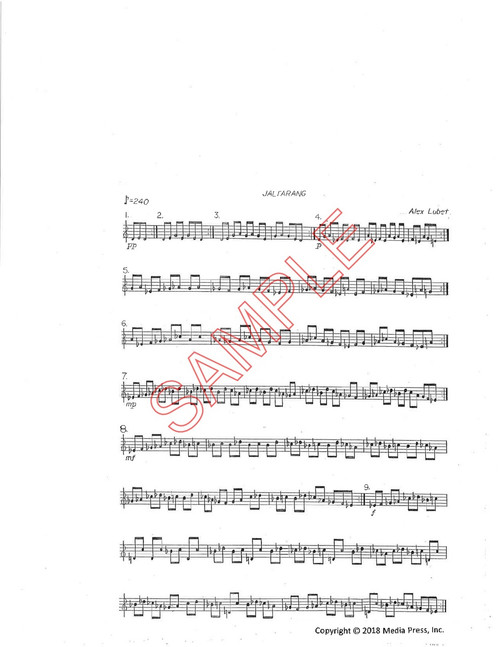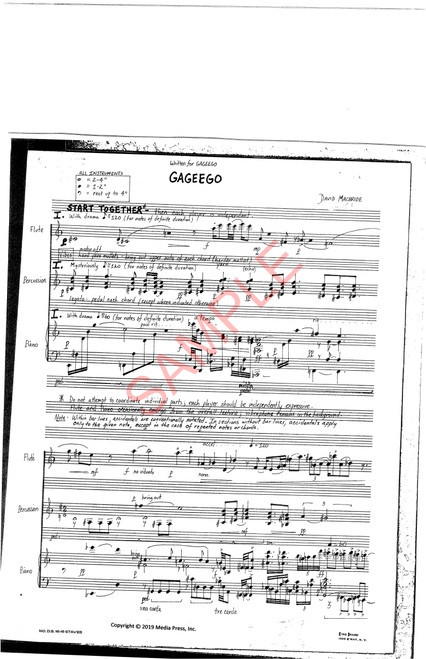Jaltarang, for piano and vibraphone or any combination of keyboards and percussion instruments of definite pitch, includes 2 scores.
Print size: Letter (8.5 x 11")
Composed in 1983, Jaltarang, is the first of dozens of structured improvisations written for a wide variety of media. It was composed for percussionist Steven Schick and pianist James Avery, one of four works written for a McKnight, Composer Fellowship. It can be performed by vibraphone and piano or any combination of keyboards and mallet percussion (and, potentially, many other combinations of instruments of definite pitch). It has received numerous performances, notable among them those by the Maelstrom Percussion Quartet at New York’s Lincoln Center.
The work’s title is taken from the little-known mallet percussion instrument of classical Indian music, whose sound is somewhat reminiscent of the vibraphone. An extended period of travel throughout India in 1975 remains one of the most important inspirations in my musical life.
Jaltarang is comprised of 21 related pitch patterns. While these are generated from a single 12-tone row, they are order in a manner that allows a gradual motion from diatonic (and tonally centered on D) to chromatic and back again, as well as short-long-short, and soft-loud-soft. Improvisation is based on guided heterophonic variation on the patterns. Throughout the work’s performance history, players have chosen a wide range of improvisational liberty, from nearly verbatim readings of the patterns themselves, to a level of freedom approximating that of tonal mainstream jazz.
Review from Percussive Notes (2021):
Jaltarang
Alex Lubet
Despite only being added to the publisher’s catalog in 2018, “Jaltarang” was first composed for and premiered by percussionist Steven Schick and pianist James Avery nearly four decades ago. Although originally written for vibraphone and piano, the work may be performed by “any combination of keyboards and percussion instruments of definite pitch,” with specific instructions provided in the score for the realization of a variable ensemble performance. (Despite the vagueness of the composer’s language, “percussion instruments of definite pitch” should be interpreted as “keyboard percussion instruments,” as a performance with timpani or RotoToms would require a prohibitively large number of drums onstage.) The score, which ostensibly consists of a single melodic line, is meant to be realized by the performers through the use of several improvisational and structural devices, and as such any two performances of the work will diverge in terms of length and internal material.
Although not included in the score, the publisher’s website includes a note from the composer which explains that “Jaltarang” takes its name “from the little-known mallet percussion instrument of classical Indian music, whose sound is somewhat reminiscent of the vibraphone.” The composer’s experiences as a traveler in India are evident in the harmonic language of the piece as well; although the work generally follows an arc from diatonicism to full chromaticism and back to diatonicism, the progression takes care to unfold through raga-like harmonic developments that allow for the improvised material to stake a claim virtually anywhere on the tonal spectrum.
The closest approximation I can think of to describing “Jaltarang” would be if Pandit Ravi Shankar had made a mashup of Frederic Rzewski’s “Les Moutons de Panurge” and Louis Andriessen’s “Worker’s Union,” and then handed the result to a jazz improviser. The piece’s 21 repeated phrases contain a deceptively deep well of exploration, and any performance will require a supreme level of creativity and confidence from the players. Therefore, I would recommend this piece only to the most capable and advanced college or professional ensembles, although I would recommend it highly. Performers who are able to take on “Jaltarang” are certain to find it a thrilling challenge and a welcome opportunity to incorporate creativity and improvisational skills in a new and uncommon way.
—Brian Graiser







